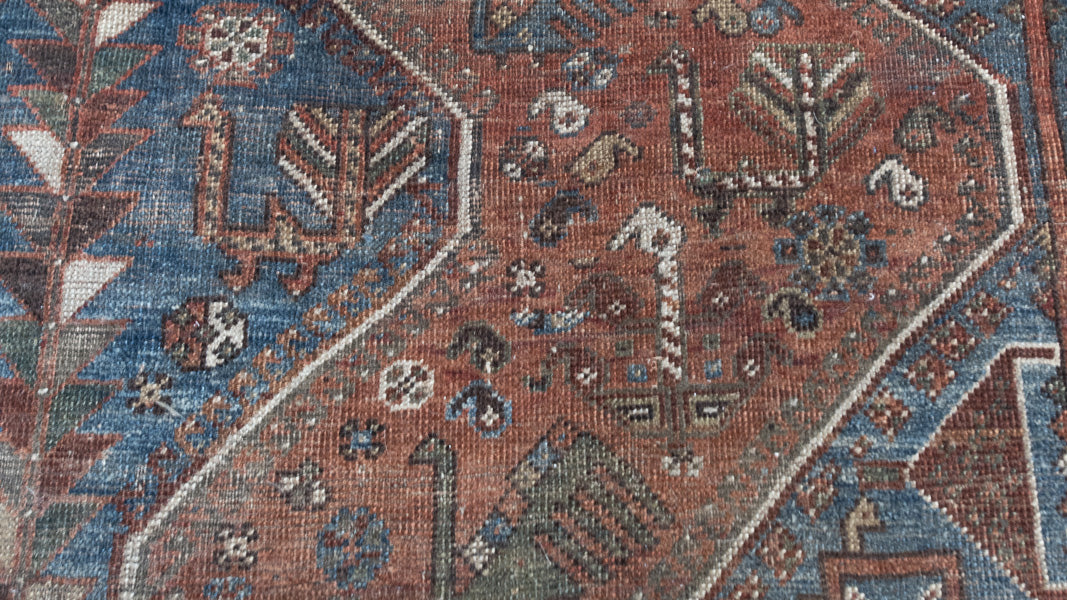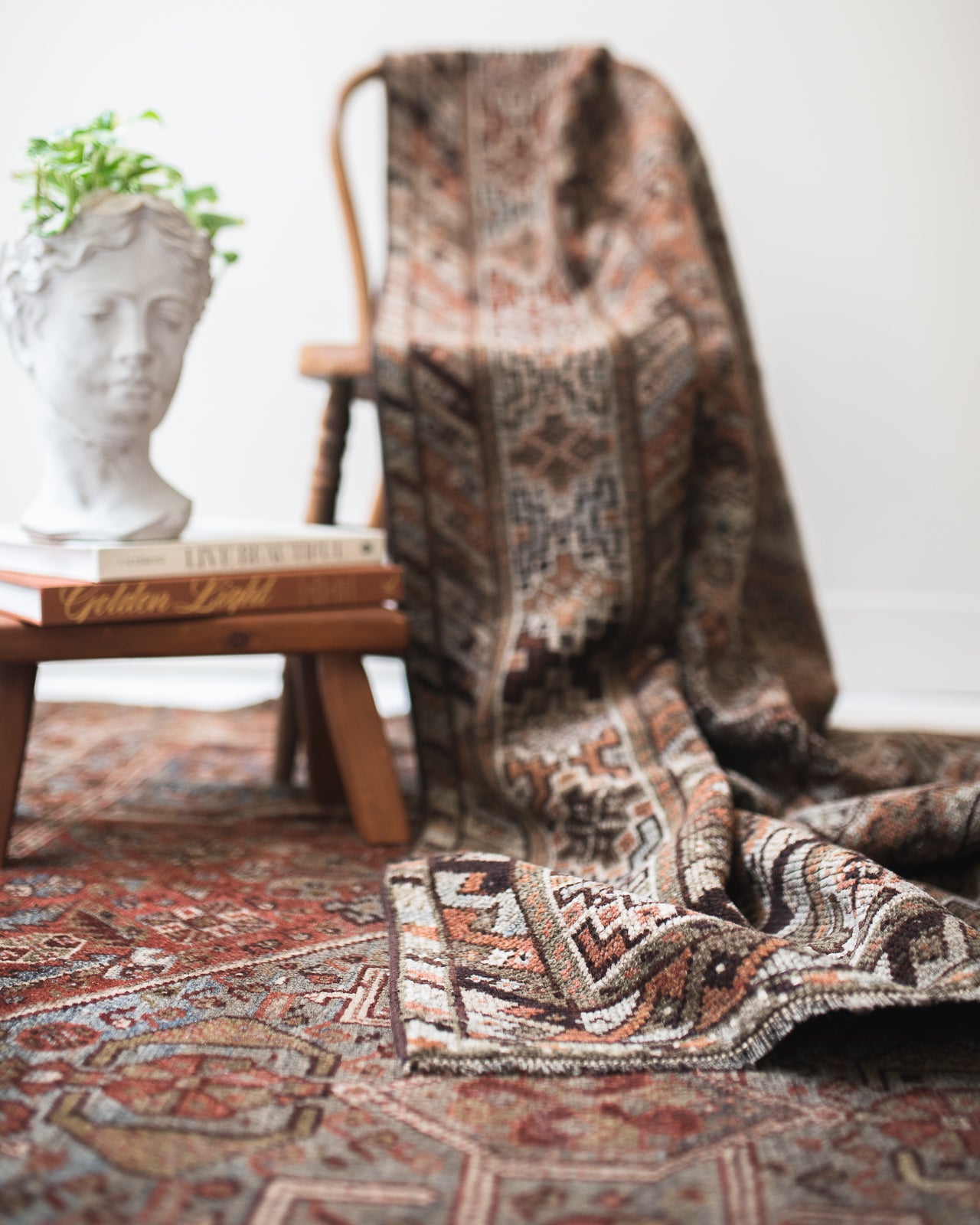Are you curious about the history and design of your vintage rug? What the motifs, or symbols, are and what they might represent? Or maybe you've only really paid close attention to the colors, textures and shapes. Whether you look from afar or inspect the details up close, oriental rugs have a language and symbolism behind every design. The vast array of cultures and historical traditions that created oriental rugs bring endless depictions, patterns and themes to this well loved and developed craft. You can use this language as clues to identify the origin and, or, the age of a vintage rug. The extent of detail and time spent weaving varies greatly, but there are some basic designs that can be broken down into a few major elements that make up most, if not all, oriental rugs.

The basics of oriental rug design
Vintage hand knotted rugs were woven on a loom, according to a design plan. The designs varied from a fairly simple design, to design with immense detail and intricacy; but will usually consist of two main variable components: the layout and motif.
- the layout is considered the greater composition of the rug: the overall structure of patterns that make up the design; usually a combination of elements such as borders (often several), medallions, corners, edges
- the motifs are the categories of smaller design details and themes that tell the story of the rug; for example: a boteh motif symbolizes the tree of life. You may be familiar with these popular terms already.
 Photographed above are two examples comparing an all over design motif vs a medallion motif. The image on the left features a vintage Persian Mahal, commonly designed with large floral and vine-like motifs scattered throughout the rug, creating an 'all over design'. The image on the right features a vintage Persian Tabriz rug, a great example of a large medallion design.
Photographed above are two examples comparing an all over design motif vs a medallion motif. The image on the left features a vintage Persian Mahal, commonly designed with large floral and vine-like motifs scattered throughout the rug, creating an 'all over design'. The image on the right features a vintage Persian Tabriz rug, a great example of a large medallion design.
The layout, or style, of a rug leads the overall aesthetic of a rug; think of this like the first impression of a rug: general colors and large design composition. A two toned repeating line in a Turkish hemp rug will have a different immediate impression than for instance, a Persian rug (like the examples above), broken up into a more complex weaving, with vast colors and pattern.
Here's a short glossary of some basic components which are used interchangeably to create endless designs:
 The illustrations above depict the key differences between a medallion layout and and all over design layout in an oriental rug.
The illustrations above depict the key differences between a medallion layout and and all over design layout in an oriental rug.
The basics of oriental rug motifs
Let’s take a closer look at some commonly found motifs. These will be all the curious little 'drawings' that fill in your rug, of course being designed by humans, are unique and varied; from heavily symbolic and realistic to imaginative and abstract. Sometimes these motifs help us identify a tribe or region. Possibly the most famous motif: a boteh (or paisley), can be traced in architecture and other artwork dating back to the 9th century and really became dominant in the 17th century. Boteh motifs became so popular through the 19th century that reproductions in Wales and Scotland led the motif to be commonly known in Eastern Europe and in turn, the Western culture. The very iconic motif is derived from the bud of a palm and was simplified over time into a curving teardrop like shape. The West came to know this design as paisley, as the town of Paisley in Scotland reproduced this pattern in mass.
Photographed above is 'Alyah | 4'7 x 6'3', a Persian Malayer rug with an all over pattern, featuring the boteh motif.
So what do these motifs tell you about your rug?
There are many symbols, ideas and lore behind the myriad of rug motifs that are used. These depictions can tell a story or serve a specific use or intention. We will get into some symbolism and color meaning later on, but let’s look at some basic examples of motif types first!

You can use these repetitive motifs as clues to "read" a rug; the layout and motifs can serve as a key identifier in a rug's history, origin and purpose. If you really study a rugs design, you can begin to identify a city style rug from a tribal rug (see image below for tribal rug example). Sometimes, a rugs design will tell a story or act as a talisman for an event, such as a pregnancy or marriage. Handmade rugs are imbued deeply into the history and the culture of the Middle East, providing prosperity for artisans and a craft to channel their faith, culture and pride into.
“The symbol which the artisan’s fingers wove into the rug was the projection not only of his subconscious motives, but also of his people and his time. The rug thus becomes a blackboard on which a people wrote its secret dream – life in the cabalistic language of symbols.”
-Félix Martí Ibáñez, M.D
A closer look into tribal rugs
The image below focuses on two motifs in a Shiraz rug; Shiraz rugs were woven in villages of southwest Iran. The weavers or Shiraz rugs were famously known to design angular shaped bird motifs, representing nightingales. These birds symbolize contentment and happiness, which maybe gives us a clue into the weavers life story. Key motifs like the birds below are the easiest way to differentiate a city rug from a tribal rug; as city rugs are not typically so geometrical or abstract. City rugs, like a Tabriz, are not usually filled with "critters" (or animals), as I like to call them.

Some other common motifs and interpretations you may find are:
cross- faith
xo,
Minimal Chaos














Comments
What a beautiful explanation of what to look for in rug design!